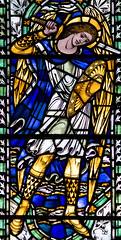 Image by Rickydavid via Flickr
Image by Rickydavid via Flickr
Last time I suggested a model of Christian diversity based upon historical connections, rather than structural unity.
Two posts ago, I mentioned a pathway towards visible unity for the Church of England and British Methodist Church. This pathway starts with the Anglican Methodist Covenant, then shared ministry leading, via Methodist and women bishops, to interchangeability of ministry and then to visible unity.
Strategically this sequence is problematic. The basic problem is the arguments in favour of unity themselves create barriers to unity.
So, we achieve shared ministry, which means closer collaboration between local churches becomes possible, so long as local church leaders (Bishop, District Chair and Superintendents) are prepared to collaborate. Interchangeability means all ministers, whilst still under their denominational authorities, are fully recognised by the other church. Visible unity is where the two churches are effectively one.
Let's say we achieve shared ministry, which is likely to happen. Does this increase or decrease the possibility of persuading the Methodist Church to adopt Bishops? It is not at all clear. Whilst it seems shared ministry is an essential step, what if people think shared ministry is sufficient, they have the freedom to manoeuvre they need, why go any further? Similarly, if interchangeability is achieved, it does not necessarily mean structural unity will happen. The costs of the final step might outweigh any tangible gains. If we have interchangeability, why go to the extra lengths of structural unity where the legislation (in Parliament) will be huge, as well as all the legal costs?
Worse, even if the necessary steps take place it doesn't mean the churches are meaningfully united. For example, the British Methodist Church is being invited to have Bishops who have the 'sign of the historic episcope', or laying on of hands. No other Methodist church has this, even where they have the title of Bishop. I don't think Methodists in Britain not value this sign; it lacks meaning for them. What does have meaning for Methodists is the means by which a Bishop is appointed. If they are voted in by church members, for example, they might be seen as genuine representatives of the people and so be accepted (this is how Bishops are supposed to be appointed - although episcopal churches are not always quite so democratic). The Presidents of Conference are the suggested candidates to be Methodist Bishops and they are elected by Conference representatives. If this is seen as sufficiently democratic, this might be easier to navigate through Conference than the sign of the historic episcopate.
But hold on. If this is so, in what sense can it be said the two churches would then be closer? The Methodists accept the sign even though they don't value it, whilst accepting Bishops for a reason the Anglicans don't value.
Note, I am not saying this is what will happen, what I am trying to do is illustrate the issues we have to face as we approach visible unity. The diagram in my last post illustrates why I think unity lies in history rather than across the branches of the tree. Trying to reconcile traditions that have developed separately is bound to encounter deep resistance, not necessarily from those who take a principled stand against further unity.



















Recent Comments